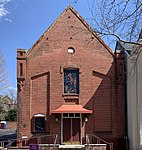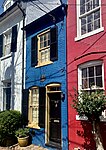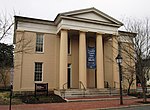Christ Church (Alexandria, Virginia)

Christ Church is an Episcopal church located at 118 North Washington Street, with an entrance at 141 North Columbus Street, in Alexandria, Virginia. Constructed as the main church in the Church of England's Fairfax Parish, the building was designed by Col. James Wren, a descendant of Sir Christopher Wren. To finance construction of the church, the Fairfax Vestry raised 31,186 pounds of Oronoco tobacco from parishioners. Construction began in 1765, under the direction of James Parsons. After four years, the church was still unfinished. The vestry relieved Parsons of his duties as overseer of the construction. John Carlyle accepted the position and handed the keys of the completed building over to the vestry in February 1773. Initially the pews were box pews and a two-tier pulpit was situated on the north side of the sanctuary. There was no font because until after the Civil War, weddings, baptisms, and the churching of women took place at home. In the mid-nineteenth century, stoves were put in the back of the church and the box pews were converted to the slips that are in use today. During a renovation later that century, the original pulpit was replaced by the current wine-glass pulpit. The only remaining hand-carved hymnal rack is in the Lee pew. The plaques on either side of the chancel were hand-lettered by Wren and have never been retouched. They display the Decalogue, the Lord's Prayer, the Apostles' Creed, and the Golden Rule. Wren used ink and then varnished his work just as an artist varnishes a finished painting. Over time the carbon in the ink and the alcohol in the varnish formed an acetate that created the wonderful burnished patina of the plaques. If you look closely, you can see Wren's brushstrokes and one drip. George Washington, Henry Lee, Robert E. Lee, Charles Simms, Philip Marsteller, and Henry Fowler are a few of the church's notable parishioners (members). Until the twenty-first century, it was tradition for sitting presidents to attend a service. Franklin Roosevelt, Winston Churchill, and Eleanor Roosevelt visited the church on January 1, 1942 to commemorate World Day of Prayer for Peace. The church was known as Fairfax Church until given the name Christ Church in 1816. It was declared a National Historic Landmark in 1970.
Excerpt from the Wikipedia article Christ Church (Alexandria, Virginia) (License: CC BY-SA 3.0, Authors, Images).Christ Church (Alexandria, Virginia)
Cameron Street, Alexandria
Geographical coordinates (GPS) Address Website Nearby Places Show on map
Geographical coordinates (GPS)
| Latitude | Longitude |
|---|---|
| N 38.806302777778 ° | E -77.047516666667 ° |
Address
Christ Episcopal Church
Cameron Street
22314 Alexandria
Virginia, United States
Open on Google Maps







